Having previously marveled at the concept of 3D printing from a distance, my perspective shifted dramatically when my partner embraced it as a hobby. Initially, I viewed it as a fascinating technological feat—an impressive representation of innovation. However, once my partner began exploring this realm, I found myself immersed in the intricacies of the practice. The allure of the Bambu A1 Mini printer—a fantastic entry point now available at a discount during extensive sale seasons—has proven to be a pivotal aspect of her journey and has piqued my curiosity as well.
Our 3D printing adventure commenced a few Christmases ago when I surprised my partner with an Ender printer. However, our experience was not without challenges. Like many beginners, she encountered technical difficulties and frustrations often inherent to 3D printing. The Ender proved less user-friendly than anticipated, reinforcing the stereotype of 3D printers as capricious machines that frequently give the illusion of functionality without delivering results. Initial efforts were often met with failed prints, but this rocky start became a stepping stone toward better options on the market.
The Shift to Bambu Lab A1 Mini
This year brought a significant turning point when my partner decided to invest in the Bambu Lab A1 Mini. The contrast in performance and user experience was stark. Prints that had once struggled for semblance were now coming out with remarkable precision and a notable reduction in errors. The accompanying software proved superior, streamlining the process and making it accessible for both novices and seasoned users. The transformation was evident; my partner transitioned from laboriously crafting single prints to effortlessly producing a diverse array of items, from practical chip clips to elaborate models like Dodger Stadium—all without the usual stumbles.
The Bambu A1 Mini does come with an exciting accessory—the AMS Lite, which is far from merely a clipboard for filament. This innovative addition enables users to experiment with multiple types of filament simultaneously, unlocking the potential for vibrant multi-colored creations. However, potential buyers should note a critical limitation: the A1 Mini’s printing bed is relatively compact, constraining projects to a size reminiscent of a two-liter soda bottle. For enthusiasts with larger ambitions, the standard Bambu Lab A1 or the advanced P1S may be worthwhile investments, particularly as they provide enhanced capacity and features tailored for more complex projects.
The adventure into 3D printing has been both enlightening and rewarding, marked by trial and triumph. The Bambu A1 Mini emerges as a commendable choice for beginners and hobbyists looking to explore this captivating technology, especially during promotional periods. While it may not cater to all project sizes, its performance, usability, and innovative capabilities present an opportunity to dive headfirst into the expansive possibilities offered by 3D printing. As my partner continues to create and experiment, I remain excited to witness the evolving landscape of this extraordinary hobby.

